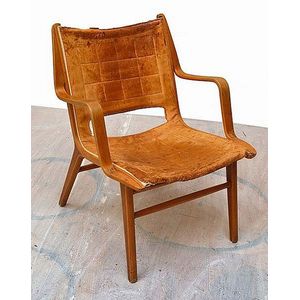Regency Armchair with Caned Seat and Leather Cushion
A Regency style armchair, the pierced back with turned supports, caned seat with fitted leather cushion, turned sabre legs. England, circa 1900. provenance: from the contents of Swanton (built 1827), Sutton Forrest, NSW
You must be a subscriber, and be logged in to view price and dealer details.
Subscribe Now to view actual auction price for this item
When you subscribe, you have the option of setting the currency in which to display prices to $Au, $US, $NZ or Stg.
This item has been sold, and the description, image and price are for reference purposes only.
- Turning - Any part of a piece of furniture that has been turned and shaped with chisels on a lathe. Turned sections include legs, columns, feet, finials, pedestals, stretchers, spindles etc. There have been many varieties and fashions over the centuries: baluster, melon, barley-sugar, bobbin, cotton-reel, rope-twist, and so on. Split turning implies a turned section that has been cut in half lengthwise and applied to a cabinet front as a false decorative support.
- Pierced Decoration - Ornamental woodwork with part of the background cut through and removed to produce an open-work pattern.
- Provenance - A term used to describe the provable history of an antique or work of art, and thus an additional aid to verifying its authenticity. Provenance can have an inflating effect on the price of an item, particularly if the provenance relates to the early settlement of Australia, a famous person, or royalty. Less significant are previous sales of the item through an auction house or dealer.
- Sabre Leg - The sabre leg is commonly associated with chairs made in the Regency or classical revival manner of the early 19th century. The form was copied from designs of the ancient Grecian chair known as a klismos found on painted classical vases. The characteristic of the sabre leg is a wide, sweeping backward curve which was frequently reeded, similar to a sabre. The sweep of the front legs was sometimes complemented by a corresponding curve in the back legs of the chair, though on most domestic furniture the sweep of the rear support was not as pronounced. Sabre legs are often encountered in reproductions of the regency style. They are uncommon in Australian furniture where, by and large, colonial craftsmen preferred to use turned legs.
- Circa - A Latin term meaning 'about', often used in the antique trade to give an approximate date for the piece, usually considered to be five years on either side of the circa year. Thus, circa 1900 means the piece was made about 1900, probably between 1895 and 1905. The expression is sometimes abbreviated to c.1900.
- Regency Period - The Regency period in English furniture design refers to the period when King George III, was declared unfit to rule in 1811, and his son ruled as proxy as Prince Regent, until 1820, and then, after the death of his father as George IV until his death in 1830. The Regency period was preceded by the Georgian period (George I, George II, and George III: 1714 - 1811), and was followed by the William IV period, which only lasted until 1837 when William IV died as was succeeded by Queen Victoria.
This item has been included into following indexes:
- chairs, singles - Georgian 542
- chairs, singles / pairs / threes, style or period
Visually similar items

An Edwardian mahogany string inlaid elbow chair, in the Art Nouveaux style
Sold by
in
for
You can display prices in $Au, $US, $NZ or Stg.

A19th century Australian cedar carver chair stamped (public works department) PWD. Height 91 cm
Sold by
in
for
You can display prices in $Au, $US, $NZ or Stg.

Danish Ax chair by Peter Hvild and Ola Molgaard-Nielsen for Fritz Hansen with heavily worn leather upholstered seat, circa 1947
Sold by
in
for
You can display prices in $Au, $US, $NZ or Stg.

A Sheraton revival high back carver chair
Sold by
in
for
You can display prices in $Au, $US, $NZ or Stg.
